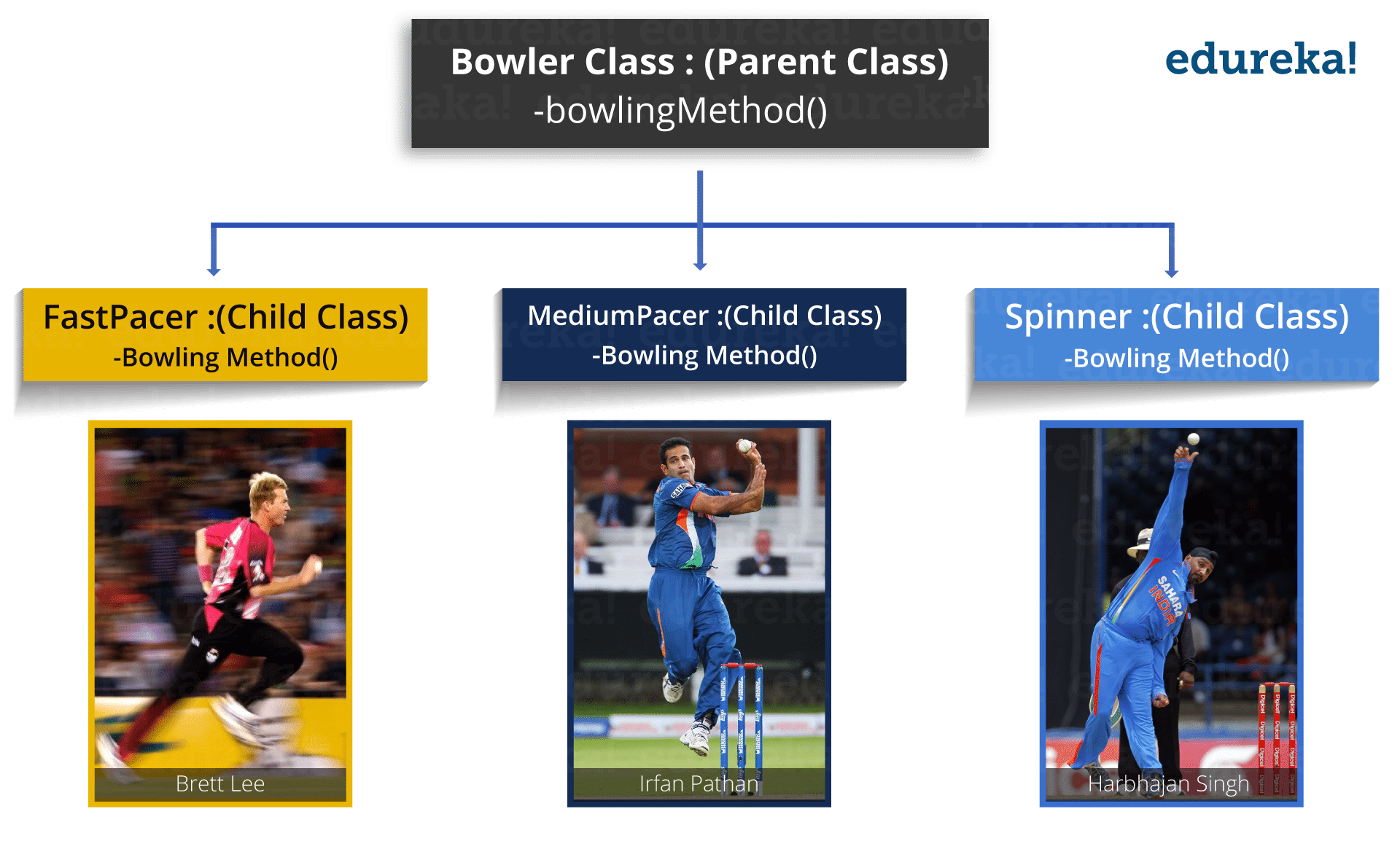Full Stack Development Internship Program
- 29k Enrolled Learners
- Weekend/Weekday
- Live Class
Object Oriented programming is a programming style which is associated with the concepts like class, object, Inheritance, Encapsulation, Abstraction, Polymorphism. Most popular programming languages like Java, C++, C#, Ruby, etc. follow an object-oriented programming paradigm.
Object Oriented programming (OOP) refers to a type of programming in which programmers define the data type of a data structure and the type of operations that can be applied to the data structure.
As Java being the most sought-after skill, we will talk about object oriented programming concepts in Java. An object-based application in Java is based on declaring classes, creating objects from them and interacting between these objects. I have discussed Java Classes and Objects which is also a part of object oriented programming concepts, in my previous blog.
The building blocks of object-oriented programming are Inheritance, Encapsulation, Abstraction, and Polymorphism. Let’s understand more about each of them in the following sequence:
Let’s get started with the first Java OOPs concept with Example, i.e. Inheritance.
In OOP, computer programs are designed in such a way where everything is an object that interact with one another. Inheritance is one such concept where the properties of one class can be inherited by the other. It helps to reuse the code and establish a relationship between different classes.
As we can see in the image, a child inherits the properties from his father. Similarly, in Java, there are two classes:
1. Parent class ( Super or Base class)
2. Child class (Subclass or Derived class )
A class which inherits the properties is known as Child Class whereas a class whose properties are inherited is known as Parent class.
Inheritance is further classified into 4 types:

So let’s begin with the first type of inheritance i.e. Single Inheritance:

In single inheritance, one class inherits the properties of another. It enables a derived class to inherit the properties and behavior from a single parent class. This will in turn enable code reusability as well as add new features to the existing code.
Here, Class A is your parent class and Class B is your child class which inherits the properties and behavior of the parent class.
Let’s see the syntax for single inheritance:
Class A
{
---
}
Class B extends A {
---
}
2. Multilevel Inheritance:
 When a class is derived from a class which is also derived from another class, i.e. a class having more than one parent class but at different levels, such type of inheritance is called Multilevel Inheritance.
When a class is derived from a class which is also derived from another class, i.e. a class having more than one parent class but at different levels, such type of inheritance is called Multilevel Inheritance.
If we talk about the flowchart, class B inherits the properties and behavior of class A and class C inherits the properties of class B. Here A is the parent class for B and class B is the parent class for C. So in this case class C implicitly inherits the properties and methods of class A along with Class B. That’s what is multilevel inheritance.
Let’s see the syntax for multilevel inheritance in Java:
Class A{
---
}
Class B extends A{
---
}
Class C extends B{
---
}
3. Hierarchical Inheritance:
 When a class has more than one child classes (sub classes) or in other words, more than one child classes have the same parent class, then such kind of inheritance is known as hierarchical.
When a class has more than one child classes (sub classes) or in other words, more than one child classes have the same parent class, then such kind of inheritance is known as hierarchical.
If we talk about the flowchart, Class B and C are the child classes which are inheriting from the parent class i.e Class A.
Let’s see the syntax for hierarchical inheritance in Java:
Class A{
---
}
Class B extends A{
---
}
Class C extends A{
---
} Hybrid inheritance is a combination of multiple inheritance and multilevel inheritance. Since multiple inheritance is not supported in Java as it leads to ambiguity, so this type of inheritance can only be achieved through the use of the interfaces.
Hybrid inheritance is a combination of multiple inheritance and multilevel inheritance. Since multiple inheritance is not supported in Java as it leads to ambiguity, so this type of inheritance can only be achieved through the use of the interfaces.
If we talk about the flowchart, class A is a parent class for class B and C, whereas Class B and C are the parent class of D which is the only child class of B and C.
Now we have learned about inheritance and their different types. Let’s switch to another OOPs concept in Java with Example i.e Encapsulation.
Encapsulation is a mechanism where you bind your data and code together as a single unit. It also means to hide your data in order to make it safe from any modification. What does this mean? The best way to understand encapsulation is to look at the example of a medical capsule, where the drug is always safe inside the capsule. Similarly, through encapsulation the methods and variables of a class are well hidden and safe.

We can achieve encapsulation in Java by:
Let us look at the code below to get a better understanding of encapsulation:
public class Employee {
private String name;
public String getName() {
return name;
}
public void setName(String name) {
this.name = name;
}
public static void main(String[] args) {
}
}
Let us try to understand the above code. I have created a class Employee which has a private variable name. We have then created a getter and setter methods through which we can get and set the name of an employee. Through these methods, any class which wishes to access the name variable has to do it using these getter and setter methods.
Let’s move forward to our third Java Based OOPs concept i.e. Abstraction.
Abstraction refers to the quality of dealing with ideas rather than events. It basically deals with hiding the details and showing the essential things to the user. If you look at the image here, whenever we get a call, we get an option to either pick it up or just reject it. But in reality, there is a lot of code that runs in the background. So you don’t know the internal processing of how a call is generated, that’s the beauty of abstraction. Therefore, abstraction helps to reduce complexity. You can achieve abstraction in two ways:
a) Abstract Class
b) Interface
Let’s understand these Java OOPs concepts in more detail.
Abstract class: Abstract class in Java contains the ‘abstract’ keyword. Now what does the abstract keyword mean? If a class is declared abstract, it cannot be instantiated, which means you cannot create an object of an abstract class. Also, an abstract class can contain abstract as well as concrete methods.
Note: You can achieve 0-100% abstraction using abstract class.
To use an abstract class, you have to inherit it from another class where you have to provide implementations for the abstract methods there itself, else it will also become an abstract class.
Let’s look at the syntax of an abstract class:
Abstract class Mobile { // abstract class mobile
Abstract void run(); // abstract method
Interface: Interface in Java is a blueprint of a class or you can say it is a collection of abstract methods and static constants. In an interface, each method is public and abstract but it does not contain any constructor. Along with abstraction, interface also helps to achieve multiple inheritance in Java.
Note: You can achieve 100% abstraction using interfaces.
So an interface basically is a group of related methods with empty bodies. Let us understand interfaces better by taking an example of a ‘ParentCar’ interface with its related methods.
public interface ParentCar {
public void changeGear( int newValue);
public void speedUp(int increment);
public void applyBrakes(int decrement);
}
These methods need be present for every car, right? But their working is going to be different.
Let’s say you are working with manual car, there you have to increment the gear one by one, but if you are working with an automatic car, that time your system decides how to change gear with respect to speed. Therefore, not all my subclasses have the same logic written for change gear. The same case is for speedup, now let’s say when you press an accelerator, it speeds up at the rate of 10kms or 15kms. But suppose, someone else is driving a super car, where it increment by 30kms or 50kms. Again the logic varies. Similarly for applybrakes, where one person may have powerful brakes, other may not.
Since all the functionalities are common with all my subclasses, I have created an interface ‘ParentCar’ where all the functions are present. After that, I will create a child class which implements this interface, where the definition to all these method varies.
Next, let’s look into the functionality as to how you can implement this interface.
So to implement this interface, the name of your class would change to any particular brand of a Car, let’s say I’ll take an “Audi”. To implement the class interface, I will use the ‘implement’ keyword as seen below:
public class Audi implements ParentCar {
int speed=0;
int gear=1;
public void changeGear( int value){
gear=value;
}
public void speedUp( int increment)
{
speed=speed+increment;
}
public void applyBrakes(int decrement)
{
speed=speed-decrement;
}
void printStates(){
System.out.println("speed:"+speed+"gear:"+gear);
}
public static void main(String[] args) {
// TODO Auto-generated method stub
Audi A6= new Audi();
A6.speedUp(50);
A6.printStates();
A6.changeGear(4);
A6.SpeedUp(100);
A6.printStates();
}
}
Here as you can see, I have provided functionalities to the different methods I have declared in my interface class. Implementing an interface allows a class to become more formal about the behavior it promises to provide. You can create another class as well, say for example BMW class which can inherit the same interface ‘car’ with different functionalities.
So I hope you guys are clear with the interface and how you can achieve abstraction using it.
Finally, the last Java OOPs concept is Polymorphism.
Polymorphism means taking many forms, where ‘poly’ means many and ‘morph’ means forms. It is the ability of a variable, function or object to take on multiple forms. In other words, polymorphism allows you define one interface or method and have multiple implementations.
Let’s understand this by taking a real-life example and how this concept fits into Object oriented programming.

Let’s consider this real world scenario in cricket, we know that there are different types of bowlers i.e. Fast bowlers, Medium pace bowlers and spinners. As you can see in the above figure, there is a parent class- BowlerClass and it has three child classes: FastPacer, MediumPacer and Spinner. Bowler class has bowlingMethod() where all the child classes are inheriting this method. As we all know that a fast bowler will going to bowl differently as compared to medium pacer and spinner in terms of bowling speed, long run up and way of bowling, etc. Similarly a medium pacer’s implementation of bowlingMethod() is also going to be different as compared to other bowlers. And same happens with spinner class.
The point of above discussion is simply that a same name tends to multiple forms. All the three classes above inherited the bowlingMethod() but their implementation is totally different from one another.
Polymorphism in Java is of two types:
Run time polymorphism: In Java, runtime polymorphism refers to a process in which a call to an overridden method is resolved at runtime rather than at compile-time. In this, a reference variable is used to call an overridden method of a superclass at run time. Method overriding is an example of run time polymorphism. Let us look the following code to understand how the method overriding works:
public Class BowlerClass{
void bowlingMethod()
{
System.out.println(" bowler ");
}
public Class FastPacer{
void bowlingMethod()
{
System.out.println(" fast bowler ");
}
Public static void main(String[] args)
{
FastPacer obj= new FastPacer();
obj.bowlingMethod();
}
}
Compile time polymorphism: In Java, compile time polymorphism refers to a process in which a call to an overloaded method is resolved at compile time rather than at run time. Method overloading is an example of compile time polymorphism. Method Overloading is a feature that allows a class to have two or more methods having the same name but the arguments passed to the methods are different. Unlike method overriding, arguments can differ in:
Let us look at the following code to understand how the method overloading works:
class Adder {
Static int add(int a, int b)
{
return a+b;
}
static double add( double a, double b)
{
return a+b;
}
public static void main(String args[])
{
System.out.println(Adder.add(11,11));
System.out.println(Adder.add(12.3,12.6));
}
}I hope you guys are clear with all the Java OOPs Concepts with Examples that we have discussed above i.e inheritance, encapsulation, abstraction and polymorphism. Now you can make your Java application more secure, simple and re-usable using Java OOPs concepts. Do read my next blog on Java String where I will be explaining all about Strings and its various methods and interfaces.
Now that you have understood the Object Oriented Programming (OOPs) concepts in Java, check out the Java training by Edureka, a trusted online learning company with a network of more than 250,000 satisfied learners spread across the globe. Edureka’s Java J2EE and SOA training and certification course is designed for students and professionals who want to be a Java Developer. The course is designed to give you a head start into Java programming and train you for both core and advanced Java concepts along with various Java frameworks like Hibernate & Spring.
Got a question for us? Please mention it in the comments section of this “Object Oriented Programming” blog and we will get back to you as soon as possible.
 Thank you for registering Join Edureka Meetup community for 100+ Free Webinars each month JOIN MEETUP GROUP
Thank you for registering Join Edureka Meetup community for 100+ Free Webinars each month JOIN MEETUP GROUPedureka.co
Good and clear notes. Also I will recommend the unique book “OOP Concepts Booster” to get strong hold on it in shortest time..
Thank you so much for sharing such a informative article !
this blog are very easy to understand for beginners like me!
all oops concepts are very clearly
https://www.exltech.in/java-training.htm
very informative blog !!
all concepts are explain very clearly,this blog are really helpful
for java beginners.
https://www.exltech.in/java-training.html
Very nice explanation and example. Thanks a lot.
Really helpful blog..It is perfect for beginners..
Thanks for the information, lots of info here.
Would love to connect.
Do check out our training platform at Experfy — www.experfy.com/training
We are a Harvard-incubated company and the biggest data science/AI/machine learning/Java marketplace for enterprises.
Hope to connect.
Cheers,
Kavita Lalwani
That’s nice article, I’m beginner, where can I get daily updates?
Hey Sujit, subscribe to our blogs and Youtube channel to not miss out on any updates by us. Cheers :)
Very nice explanation and example. Thanks a lot.
Thanks for the information and to share such a nice post on object oriented programming.
Thank you Priya for appreciating our work. Do browse through other blogs and watch our tutorial videos on Youtube – https://www.youtube.com/watch?v=cXj1hHdMNk4
could you please tell me how abstraction is applied, i understand abstraction is hiding the logic but here how its been applied A6.speedUp(50); user know this information right